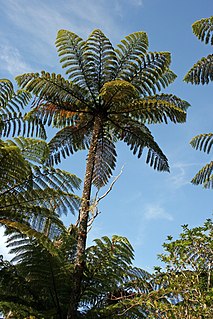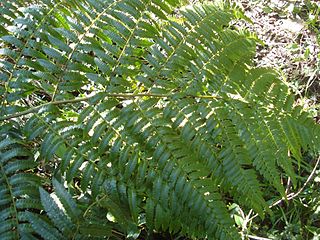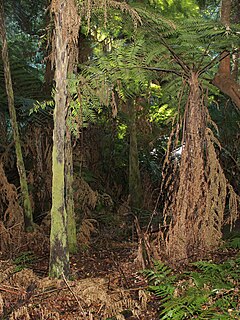
Cyathea is a genus of tree ferns, the type genus of the fern order Cyatheales.

Sphaeropteris medullaris, synonym Cyathea medullaris, commonly known as mamaku or black tree fern, is a large tree fern up to 20 m tall. It is distributed across the south-west Pacific from Fiji to Pitcairn Island. Its other Māori names include katātā, kōrau, or pītau.

Cyathea affinis is a variable species of tree fern native to Fiji, Samoa, the Cook Islands, Austral Islands, Tahiti, and the Marquesas Islands. The trunk of this plant is erect and 2–6 m tall. Fronds are bipinnate and 2–3 m in length. The rachis and stipe are pale to brown in colour, or flushed with red towards the pinnule rachis. The stipe is sparsely covered in narrow basal scales, which are pale to dark and have broad fragile edges. Characteristically of this species, the lowest one or two pairs of pinnae may be slightly reduced and occur towards the base of the stipe. Sori are located near the pinnule midvein and are partially or fully covered by indusia, which open towards the pinnule margin.
Alsophila albidosquamata, synonyms Cyathea albidosquamata and Sphaeropteris albidosquamata, is a species of tree fern native to the Maluku Islands, New Guinea and the Bismarck Archipelago, where it grows in rain forest and montane forest at an altitude of 620–2,500 metres (2,000–8,200 ft). The trunk is erect and about 2 m tall. Fronds are bi- or tripinnate and 1–1.5 m in length. The lower surface of the rachis is covered in scales and the stipe has scattered scales throughout its length. These are glossy and pale, with dull, fragile edges. Sori occur near the fertile pinnule midvein and have flat indusia which resemble small saucers.
Alsophila biformis, synonym Cyathea biformis, is a species of tree fern native to New Guinea and the Maluku Islands, where it grows against trees in mossy forest and rain forest at an altitude of 850–2200 m. The climbing trunk is very thin, only 1–2 cm in diameter, but can reach 3 m in height. The apex of the trunk is covered in scales. Two types of fronds are produced, simple pinnate fronds, which are sterile, and bipinnate fronds, which may be fertile. The stipe is smooth, glossy and very dark, almost to the point of being black. It is covered at the base with long, very dark scales that have a pale margin. Fertile pinnules are distinctly stalked and lobed. Sori occur in four pairs per pinnule lobe and lack indusia.
Alsophila buennemeijeri, synonym Cyathea buennemeijeri, is a species of tree fern endemic to the Natuna Islands in Indonesia. In the World Geographical Scheme for Recording Plant Distributions, these islands are treated as part of Kalimantan. A. buennemeijeri grows in open scrub at an altitude of about 600 m. This rare species is known only from the summits of two low hills. The trunk is erect and may be 5 m tall or more. Fronds are bi- or tripinnate and 2–3 m long. The stipe is dark and covered with spines at the base, as well as numerous scattered dark scales with pale, fragile edges. Sori occur near the midvein of fertile pinnules and are covered by thin, fragile indusia that resemble cups in shape.
Alsophila caudata, synonym Cyathea caudata, is a species of tree fern native to the islands of Luzon and Mindanao in the Philippines, where it grows in montane forest. The trunk is erect and up to 4 m tall or more. Fronds are bi- or tripinnate and 1–2 m long. The stipe is warty and covered with dark, narrow, glossy scales. Sori are borne near the midvein of fertile pinnules and are protected by firm, brown indusia. As of April 2022, Plants of the World Online treated it as a synonym of Alsophila speciosa.
Alsophila costularis, synonyms Cyathea chinensis and Sphaeropteris chinensis, is a species of tree fern native to Yunnan in China, Sikkim in India, as well as Nepal, Myanmar, Laos and Vietnam. Plants grow in forest and montane forest at an altitude of 900–1800 m. The trunk is erect and 1–2 m tall. Fronds are bipinnate and 1–2 m long. The stipe is either long and warty or has short spines towards the base as well as scattered glossy dark brown scales with fragile edges. Sori occur near the midvein of fertile pinnules and are covered by thin indusia.
Alsophila hermannii, synonym Cyathea christiiCopel., is a species of tree fern endemic to Mindanao in the Philippines, where it grows in forest at an altitude of 900–1800 m. The trunk is erect and may be 5 m tall or more. Fronds are bi- or tripinnate and 2–3 m long. The stipe is covered with some warts and narrow, brown scales. Sori occur near the midvein of fertile pinnules and are covered by thin, fragile indusia.
Cyathea decora is a species of tree fern native to Ecuador and possibly other parts of western South America. Little is known about this species. The name is the source of some taxonomic confusion: as of July 2021, Plants of the World Online regarded "Cyathea decora" as an unplaced name, and it was not listed at all in World Ferns.

Cyathea corcovadensis is a species of tree fern native to Paraguay and Serra do Mar in southern Brazil, where it grows in primary and secondary forest, as well as scrub, at an altitude of 250–2100 m. The erect trunk is short, usually about 30–60 cm tall. Fronds are bipinnate and 2.5 m or more in length. The rachis ranges in colour from brown to purplish and is covered with warts and scattered brown scales. Sori occur either between the fertile pinnule midvein and the edge of the lamina or just beside the midvein. They lack indusia. C. corcovadensis is a variable species, especially in terms of pinnule shape and degree of dissection.
Cyathea croftii is a species of tree fern endemic to Manus Island in the Admiralty Islands, where it grows in damp forest on steep slopes at an altitude of about 500 m. It is relatively uncommon in the wild. The trunk is erect, up to 3 m tall and about 6 cm in diameter. Fronds bi- or tripinnate and 2–3 m long. The rachis and stipe are often light green, particularly when young. They are slender and covered with glossy brown scales towards the base. Sori are small and occur in rows, one along each side of the pinnule midvein. They are covered by thin indusia.
Alsophila dryopteroides, synonym Cyathea dryopteroides, is a tree fern native to Puerto Rico, where it grows where it grows in shaded areas and cloud forest at an altitude of 1000–1200 m. The erect trunk may be 1.3 m tall and approximately 5 cm in diameter. Fronds are pinnate and up to 1.6 m long. The rachis is often purplish brown and covered with scales, usually on the underside. The scales range in colour from golden brown to bicoloured. Sori occur along each side of the pinnule midvein and indusia are cup-like.
Alsophila exilis, synonym Cyathea exilis, is a species of tree fern endemic to the Cape York Peninsula in Queensland, Australia, where it grows in vine forest on a substrate of sandstone. It is a rare plant known only from one location, specifically by a stream in Mann Creek in the William Thompson Range. In its natural habitat, A. exilis is reportedly accompanied by Pandanus and Calamus plants. The trunk is erect, up to 4 m tall and 4–8 cm in diameter. It produces several buds, often one at each stipe base. Fronds are bipinnate and up to 1 m long. The rachis and stipe range in colour from brown to dark brown or black-brown and are covered in blunt spines and scales. The scales are dull brown in colour and bear terminal setae, mostly one each. Sori are round and occur on either side of the pinnule midvein. Indusia are absent.
Alsophila heterochlamydea, synonym Cyathea heterochlamydea, is a little-known species of tree fern native to the islands of Luzon, Panay, Negros and Mindanao in the Philippines, where it grows in montane forest. The trunk of this plant is erect and usually up to 4 m tall or more. Fronds may be bi- or tripinnate and 1–2 m in length. The stipe is warty and/or bears short spines and scales. These scales are dark, glossy and have a narrow pale margin. Sori are borne near the fertile pinnule midvein and are protected by firm, brown indusia.

Cyathea delgadii is a widespread species of tree fern. It is native to Central America, and much of South America. The specific epithet delgadii refers to Gancho do Generale Delgado, along the road to Caldas Novas, Brazil, where the type material was collected.
Alsophila crassicaula, synonym Cyathea ledermannii, is a species of tree fern native to Papua New Guinea and Bougainville Province in the Solomon Islands, where it is common in submontane rain forest at an altitude of 1000–3000 m. The trunk of this plant is erect and grows to about 3 m in height. Fronds may be bi- or tripinnate and up to 2 m in length. The rachis is purplish brown in colouration and usually bears basal scales. These scales range from pale, to brown, to bicoloured. Sori are borne on each side of the pinnule midvein. They are protected by firm indusia.

Alsophila leichhardtiana, synonym Cyathea leichhardtiana, the prickly tree fern, is a plant in the tree fern family, Cyatheaceae, found in eastern Australia. It is a common species found in moist situations, in and near rainforests. It was named in honour of the explorer and botanical collector Ludwig Leichhardt.
Cyathea holdridgeana, synonym Cyathea albomarginata, is a species of tree fern native to Panamá and Costa Rica. It grows in wet forests at elevations of 2400–2800 m, considerably higher than most other tree ferns of Central America.

Alsophila crinita, synonym Cyathea crinita, is a species of tree fern native to India and Sri Lanka. It is considered to be endangered.






